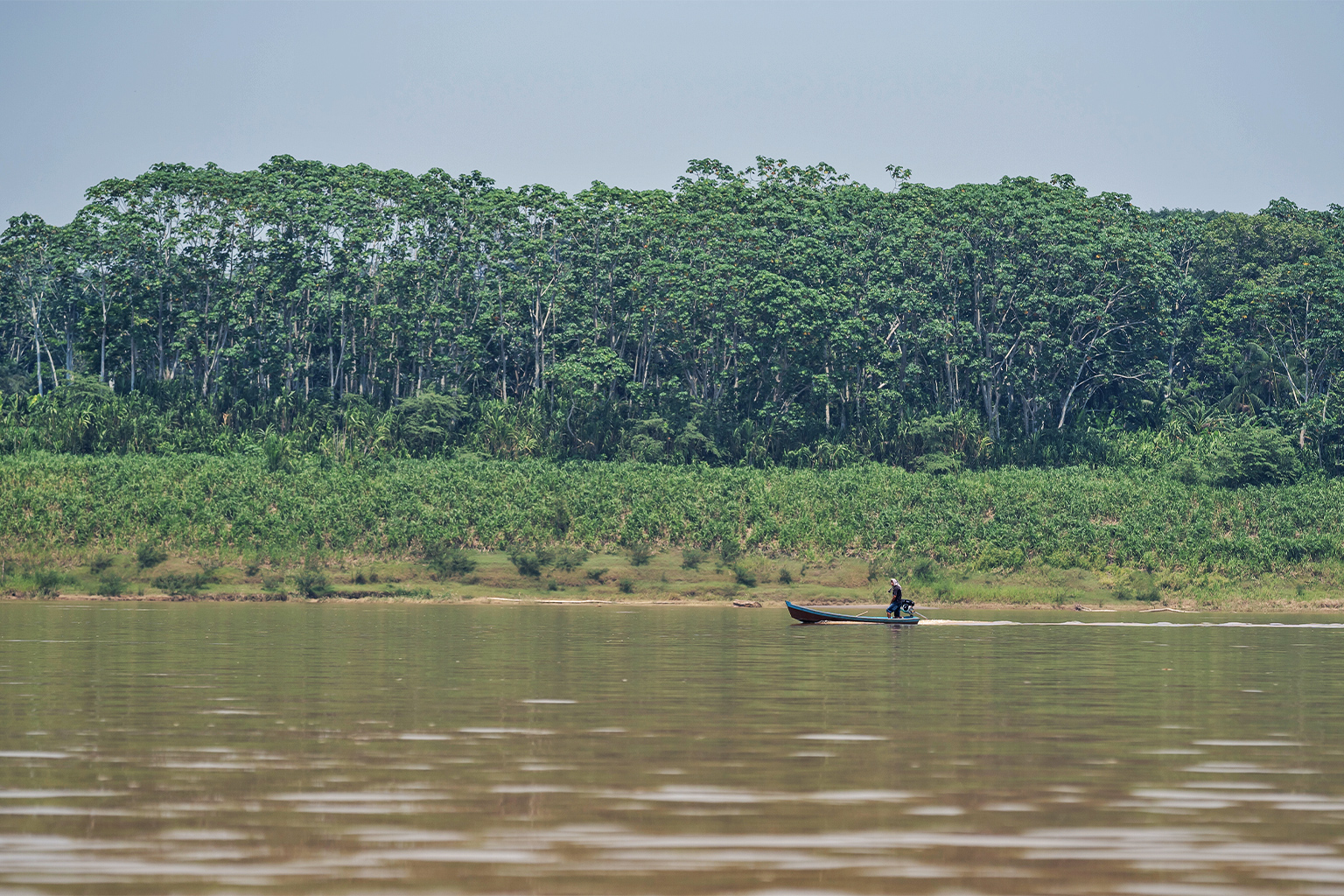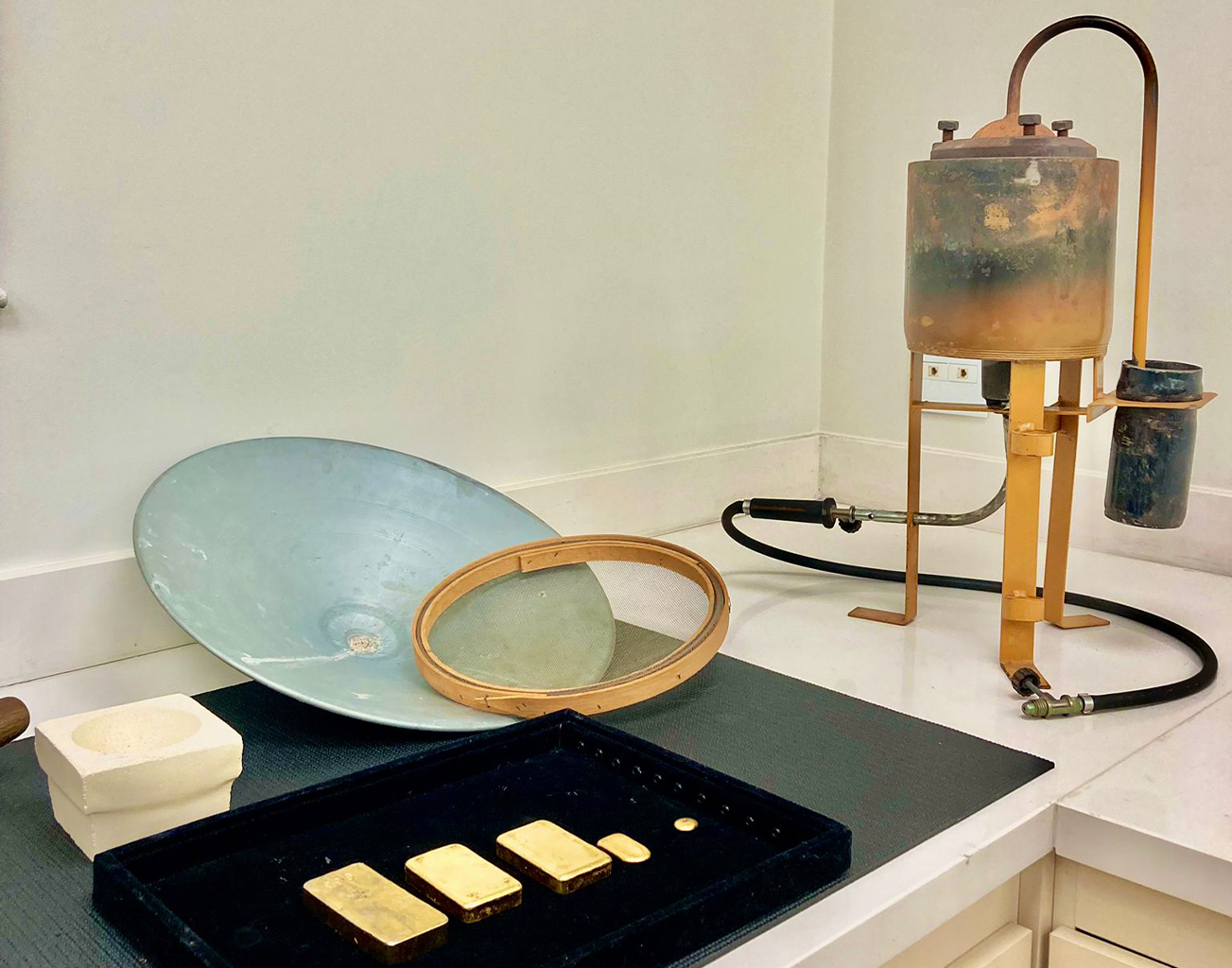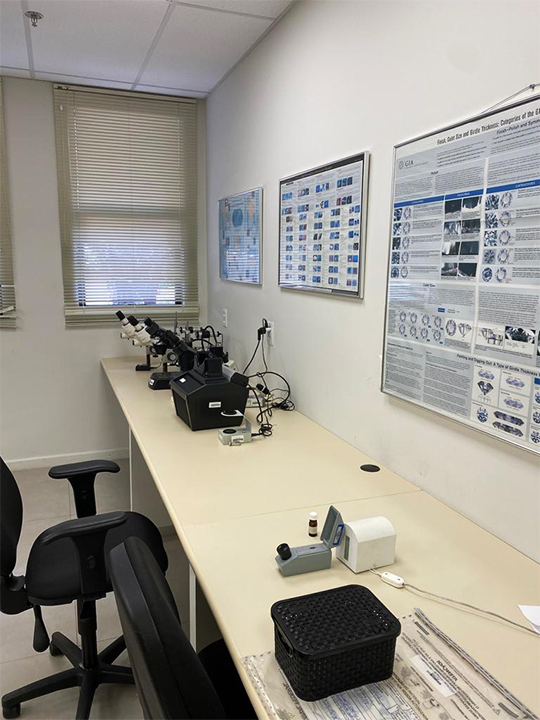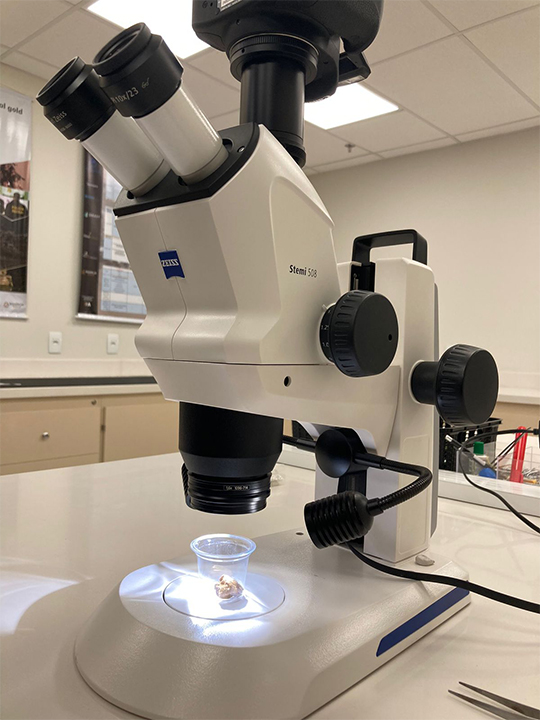- Launched in 2019, the Ouro Alvo program is creating a gold database with samples obtained from different parts of Brazil.
- The information is allowing the Federal Police to create a chemical fingerprint of each sample, which they can then use to cross-reference the origin of seized or suspicious gold.
- This strategy could be complemented with other methods, including physically tagging the gold and tracking transactions using blockchain.
- While technology can be a great ally to fight the illegal gold trade, experts say the country still needs stricter regulations governing the industry.
PORTO VELHO, Brazil — Cruising north in a speedboat along the Madeira River, the signs of Brazil’s illegal gold mining boom are everywhere: mounds of sand extracted from the riverbed sit along the banks, and dozens of smoking dredging rafts operate at full steam.
Mongabay reported from the region in November 2022, a few weeks after a police operation that destroyed dozens of rafts, known locally as dragas or balsas. But with gold prices hovering at near-record highs, for many illegal mining groups the potential profits outweigh the risks.
In January, Brazilian security forces launched a long-awaited crackdown to rid the Yanomami Indigenous Territory of thousands of illegal miners, destroying dragas and other mining equipment, as well as a plane and a helicopter, and restricting air traffic to cut off a key supply route for food and fuel for the mining camps.
But at more than 500 million hectares (about 1.2 billion acres), an area 10 times larger than the state of California, the Brazilian Amazon is far too big to police using manpower.
Advanced forensics techniques are therefore essential for complex, time-consuming investigations: to identify the origins of illegal gold, take down well-funded mining gangs, and block the illegal trade that destroys forests, ruins Indigenous communities and poisons rivers and natural habitats.

“Judges or prosecutors would always ask us if we could know the origin of seized gold,” Ricardo Moraes, a forensics expert and manager of the Brazilian Federal Police’s Ouro Alvo program, told Mongabay by video call. “And that’s the question we are trying to answer.”
Ouro Alvo, or “Clean Gold,” was launched in 2019 when Brazil’s current illegal mining boom was gathering pace. Since then, the police’s scientific experts have been collecting samples and conducting analyses to be able to identify gold from different regions of the country, whether from the Yanomami land or the Madeira River.
In these analyses, the experts combine different methodologies to obtain information about the molecular composition of the gold, its atomic structure, and the morphological features of each sample.
With this information, the police are creating a collection of unique gold signatures from each of the country’s mining regions, and feeding it into a database called Ouroteca.
So now, when they need to confirm the origin of a suspicious sample, they can simply analyze it and compare the results to Ouroteca to know with a high degree of confidence where the gold comes from.
On Apr. 1, investigative journalism outlet Repórter Brasil and NBC reported on how two alleged American gold smugglers and a Brazilian had their 35 kg (77 pounds) gold cargo — worth nearly $2.3 million — seized by authorities at Manaus airport after agents inspected it and matched it to a database, confirming its illicit origins.
The idea, according to Moraes, is to eventually contribute to a system similar to, and just as effective, as the Kimberley Process Certification Scheme that’s used for combating sales of so-called blood diamonds from conflict regions.
“For jewelry or metals, many countries have generated this awareness, having a sustainable development of knowing the origins of that product so as not to buy a product that is of dubious origin, the blood gold,” Moraes said.

Not all gold is equal
Often, determining the exact origin of seized gold is challenging, making it harder for police to say with certainty that it has an illicit origin. However, there are ways to overcome this.
“Gold is a metal alloy. Its main constituent is gold, but there’s no such thing as 24-karat gold — there are always impurities of silver, copper, lead and other elements, even if it is in small quantities,” Moraes said. These impurities, some of which remain in trace amounts even after the gold has been refined, are what allow the experts to track it back to its origin.
Usually, the first method used by the Federal Police to determine the nature of these impurities is X-ray fluorescence. One of its strengths is that it doesn’t have to be done in a lab; a scan using a handheld analyzer yields information about the ore’s atomic structure within seconds.
These results indicate the place where the sample was extracted from, and can then be checked against the documentation provided by the owner to confirm that the gold comes from where they declared.
When the police need a more detailed analysis, the team can send the sample to a lab, where sophisticated machines run what’s known as stable isotope detection. In this analysis, the researchers can look at the atomic structure of the impurities found in the gold. Some atoms from these impurities, such as lead and silver, exist in nature in different stable forms.
Silver atoms, for example, can have 60 or 62 neutrons in their structure. These different stable forms, or isotopes, can coexist in the same place, but their relative proportions are often specific to a certain region. Each proportion is called an isotopic signature or fingerprint, and experts can trace back the place where it comes from by analyzing the signature of the impurities.

Rapid expansion
Illegal mining in Brazil expanded rapidly under the presidency of Jair Bolsonaro, in office from 2019 to 2022. In the Yanomami Indigenous Territory, where illegal mining has caused a humanitarian crisis, 1,782 hectares (4,403 acres) of land were destroyed by illegal mining in 2022 alone, a 54% increase from the previous year.
According to research collective MapBiomas, more than 200,000 hectares (494,000 acres) of land in Brazil are devoted to mining, a sixfold increase since 1985, with about 90% of artisanal mining concentrated in the Amazon region.
Between 2015 and 2020, half of the gold traded by Brazil, amounting to 229 metric tons, contained evidence of illegality, according to a study conducted by the nonprofit organization Instituto Escolhas. The same organization estimates that since 2010, illegal mining in Indigenous lands and protected areas has increased fivefold and threefold, respectively.
In addition to the Ouroteca gold database, the Federal Police launched an operation to arrest members of a group involved in the buying and selling of illegal gold mined from the Yanomami land. Suspects rounded up in the operation include businessmen, lawyers, a government official and an airline employee, all allegedly involved in a network that transacted more than 422 million reais ($81 million) in flows of cash in five years.

Since the crackdown began, images of illegal miners fleeing have proliferated in the media, with reports suggesting many have simply hopped across the border to Guyana, French Guiana, or other Amazonian states in Brazil, such as Pará or even deeper into the Amazon.
There are already signs of the latter, such as the destruction of a mining balsa in the Médio Juruá region of Amazonas state in November last year.
The miners’ ability to recover quickly from the crackdown and begin operating anew elsewhere is in large part possible because many of the criminal structures supporting the industry are well-established.
“Organized crime in general, especially those involved in drug trafficking, are migrating to gold,” Moraes said. “Because, in theory, dealing with gold is safer than drugs.”
And because gold can easily be melted down and passed along into the gold supply chain, there’s virtually no distinction that can be drawn between illegal and legal gold, he said.
Players in the gold and drug trades also share the same logistics, which allows them to take part in both industries, Moraes said. “You need airplanes, for example. Many pilots who are arrested for transporting gold have a previous criminal record for trafficking drugs.”

Tracking transactions
The current legislation that regulates artisanal mining hasn’t been able to keep up with the growth of these sophisticated criminal networks, experts say.
While the Ouro Alvo program can be a valuable tool to deal with suspicious cases, experts say the gold market needs more accountability. This is particularly important in the case of small-scale mines, where most of the illegal activity takes place.
Brazilian authorities are taking action against the illegal gold trade. An order by Brazil’s Federal Revenue Service to regulate the sale of gold issued late March aims to replace the system of handwritten receipts with electronic invoices, a suggestion supported by IBRAM, the industry association representing large mining companies. From July, all gold sales will have to be made using an electronic invoice.
Speaking to Mongabay before the measure was issued Gustavo Geiser, a forensics expert with the Federal Police and member of the Ouro Alvo program, told Mongabay by video call about the fragilities of the paper based system.
“When you buy a coffee, you get a receipt and the transaction is registered,” he said. “This doesn’t happen with gold, where sales in the mine are simply registered with a pen on a piece of paper. There is no legal obligation for sellers to issue an invoice.”
On Apr. 4, Brazil’s Supreme Court Justice Gilmar Mendes suspended the “presumption of good faith” article from legal gold sales, introduced in 2013, that critics say have enabled sellers to mask murky origins of the metal.
Rodrigo Bellezoni, a public policy specialist at the Federal University of Minas Gerais’s (UFMG) Center for Territorial Intelligence (CIT), touted the importance of the Ouro Alvo program and the creation of a national gold database.
“The first step is that the state needs to generate data management in an exemplary way and this data needs to be available for [governmental] agencies,” he said.
“The second is to cross this data with satellite images so that you can monitor changes in land use in the territory you are interested in.”
However, Bellezoni said the success of a project like Ouro Alvo depends on political will. “Technology and knowledge are not a problem for Brazil,” he said. “The limiting factor is the political part.”

The database must be shared across agencies to help policymakers in decision-making, he said. Merging the gold library with other databases is also essential. “We need to integrate the official databases with fiscal data and financial transactions, in the future, to close the fence on illegal operations,” Bellezoni said.
Larissa Rodrigues, from Instituto Escolhas, called for the implementation of a traceability system that would increase transparency in the market.
The first step of this system would require all gold to be physically tagged by adding a mixture of chemical elements acting as a signature. The gold samples can then be grouped in batches, which in turn can be tracked along the supply chain.
“This tagging does not change the value of the gold in the market; the gold remains very pure,” Rodrigues said.
Once the gold is tagged, all the subsequent transactions can be tracked digitally and recorded in a blockchain, a distributed database where records can’t be altered. This way, the system would have greater transparency and prevent deforestation and human rights violations.
“Here in Brazil, legislation has always seen wildcat mining as a small and rudimentary activity, done only by a few individuals. But that is not the reality that we see today,” Rodrigues said.
“That is why the legislation in Brazil needs to be altered to adapt to this new reality where wildcat mining is a highly industrialized mining activity which occupies an enormous area in the country.”
CORRECTION (5/10/2023): An earlier version of this article stated that more than 200,000 hectares (494,000 acres) of land in Brazil are devoted to illegal mining. The number was actually referring to all kinds of mining. The piece also said that about 90% of the illegal mining is concentrated in the Amazon region, but the percentage should’ve referred to artisanal mining. The post has now been corrected.
This report is the third of a three-part series produced with support from the Serrapilheira Institute.
FEEDBACK: Use this form to send a message to the author of this post. If you want to post a public comment, you can do that at the bottom of the page.
Raids reveal how illegal gold from Indigenous lands gets laundered in Brazil
